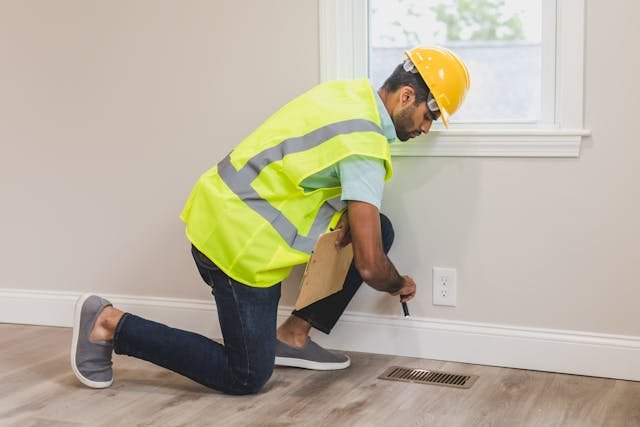
Poor ventilation in homes can often go unnoticed, yet it poses significant risks that become apparent only when visible damage or health issues arise. Insufficient airflow can lead to problems ranging from mould growth to long-term structural deterioration, resulting in costly consequences for property management, housing associations, and local councils.
This article delves into the hidden costs associated with inadequate ventilation, the health and structural threats it presents, and actionable strategies for effectively addressing these concerns.
The Hidden Costs of Inadequate Ventilation
When ventilation systems fail, the repercussions can be felt throughout a property, impacting health, finances, and structural stability.
Health Risks That Demand Attention
Poor ventilation traps moisture and indoor pollutants, leading to an unhealthy living environment. Continuous exposure to low air quality can result in various health issues, including respiratory infections, chronic coughing, and exacerbated asthma symptoms.
In the UK, the presence of damp and mould in homes contributes to nearly 5,000 new asthma cases and approximately 8,500 lower respiratory infections annually among children and adults. Furthermore, the discomfort stemming from damp and mouldy environments can adversely affect mental health, increasing stress levels and lowering overall quality of life.
Structural Damage and Deterioration
Excess moisture from poor ventilation permeates walls, ceilings, and floors, gradually undermining building materials, which can lead to rot, flaking paint, and significant structural damage.
Mould growth typically initiates in hidden areas and spreads quietly, becoming more difficult and costly to rectify the longer it is left unattended. This issue is particularly evident in older homes, where ventilation systems may already be inadequate or outdated.
The Cost Implications of Neglect
The financial implications of poor ventilation extend far beyond the immediate need for mould remediation or periodic repainting. Energy efficiency suffers as moist air demands additional energy for heating, leading to escalated energy bills.
Repeated calls for maintenance to remedy ongoing mould, damp patches, or malfunctioning HVAC systems can accumulate substantial costs. Over the long term, properties with inadequate ventilation may experience diminished value, making them less appealing to current and prospective tenants alike.
Understanding the Link Between Poor Ventilation and Mould
Mould doesn’t form overnight; it develops from a sustained imbalance of moisture, temperature, and airflow. Grasping this connection is critical for breaking the cycle of persistent mould issues.
Everyday activities such as cooking, showering, and drying laundry indoors introduce considerable moisture into the air. If this moisture is not efficiently extracted or ventilated, it condenses on cooler surfaces like walls, windows, and ceilings.
Many homes overlook early signs of mould development—small dark spots, musty odours, or ongoing condensation—often dismissing them as insignificant. However, these are clear warning signals of an underlying ventilation issue that can worsen if left unaddressed.
We spoke with Michael Zohouri, a specialist in ventilation and mould, and the founder of social housing retrofit company Pyramid Eco, who stated, “Inadequate ventilation is one of the most persistent challenges in housing sustainability projects. Without effective intervention, even the best-intentioned retrofit efforts can fall short of their aims.”
Effective Strategies for Improved Ventilation
Addressing poor ventilation involves more than just installing a few extractor fans; it requires a comprehensive, strategic approach. Solutions range from advanced ventilation systems to promoting simple behavioural changes among residents.
Investing in Modern Ventilation Technologies
Modern ventilation systems, such as Mechanical Ventilation with Heat Recovery (MVHR) units, are highly effective at managing indoor air quality. These systems extract stale, moist air while introducing fresh, filtered air and recovering heat to enhance energy efficiency.
Upgrading or installing ventilation systems in residential properties, particularly older ones, is essential for maintaining consistent airflow and reducing conditions conducive to mould growth.
Enhancing Existing Ventilation Infrastructure
Not all buildings necessitate a complete overhaul of their ventilation setup. Simple upgrades, such as adding extractor fans in bathrooms and kitchens, can significantly enhance air quality.
Additionally, ensuring that vents are unobstructed, ducts are clean, and airflow pathways are clear are vital steps. Even minor interventions can help mitigate moisture accumulation and decrease the likelihood of mould development.
Regular Maintenance and Monitoring
Both new and existing ventilation systems require routine maintenance to function optimally. Blocked vents, malfunctioning fans, or dirty filters can quickly negate the benefits provided by even the most advanced systems.
Regular inspections can identify issues early on, preventing them from evolving into larger problems. Furthermore, monitoring indoor humidity levels enables property managers to proactively address potential moisture challenges.
Educating Residents on Best Practices
Residents play a crucial role in maintaining healthy air quality in their homes. By educating them about simple practices—such as regularly opening windows, using extractor fans during cooking or showering, and avoiding indoor clothes drying—moisture build-up can be minimized.
Effective communication regarding the importance of ventilation along with easy-to-follow guidelines can empower residents to take part in fostering healthier living environments.
Why Improving Ventilation is a Long-Term Investment
Proper ventilation extends beyond just mould prevention or condensation reduction; it contributes to creating living spaces where residents breathe easily, buildings maintain structural integrity, and operational costs remain reasonable.
The time to act is not just when mould becomes visible or health complaints arise—it’s now. Investing in ventilation represents more than just a technical fix; it is a commitment to long-term well-being, sustainability, and intelligent housing management.






